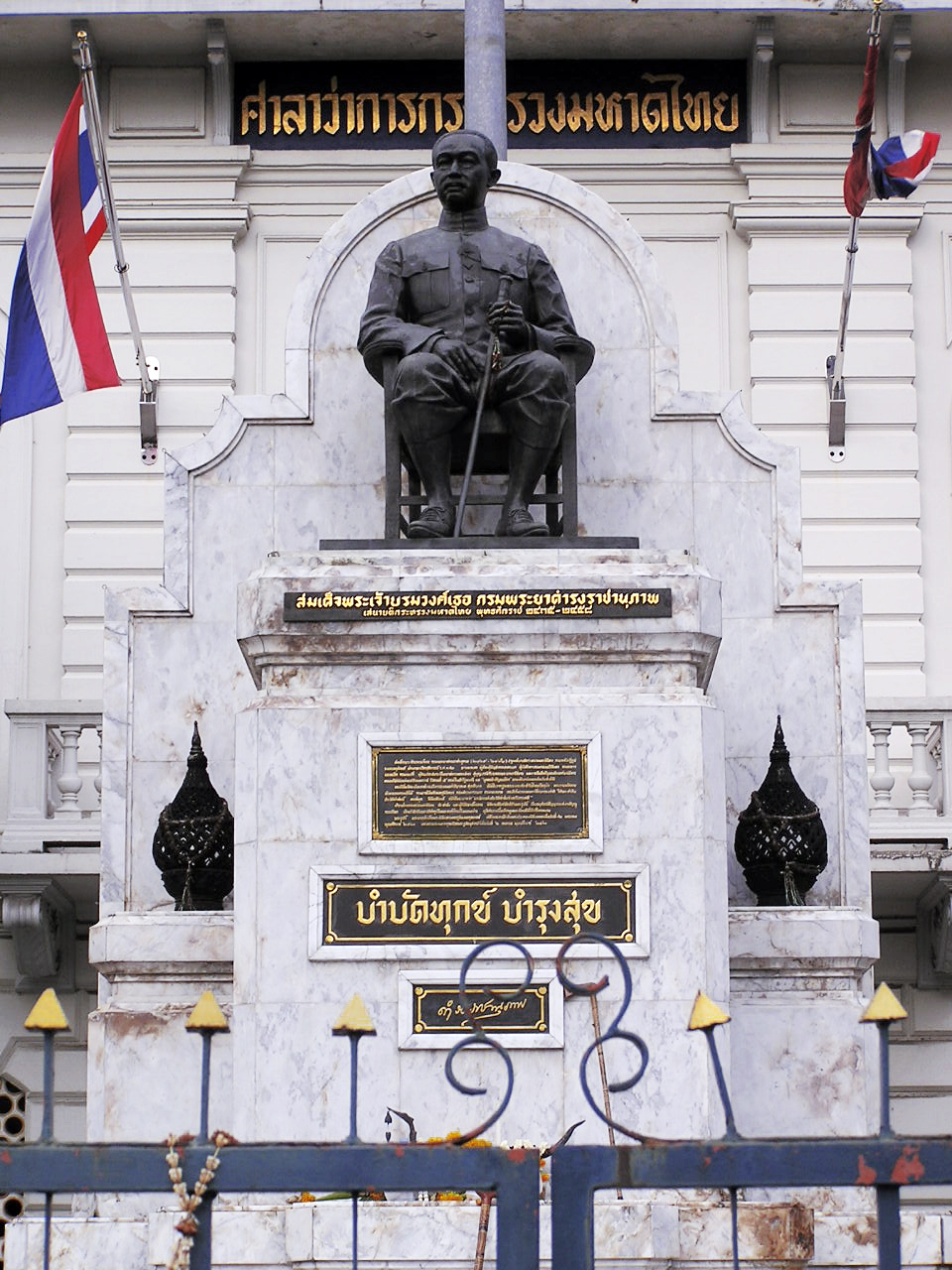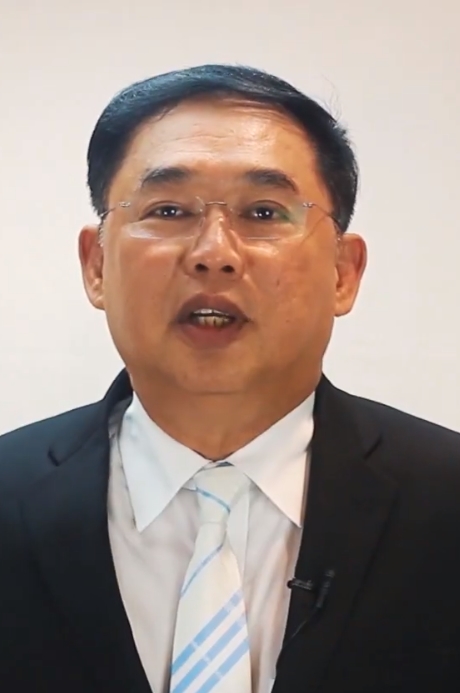|
Ministry Of Interior (Thailand)
The Ministry of Interior of the Kingdom of Thailand ( Abrv: MOI; th, กระทรวงมหาดไทย, ) is a cabinet-level department in the Government of Thailand. The ministry has wide ranging responsibilities. It is responsible for local administration, internal security, citizenship, disaster management, road safety, land management, issuance of national identity cards, and public works. The ministry is responsible for appointing the 76 governors of the Provinces of Thailand. The Minister of Interior ( th, รัฐมนตรีกระทรวงมหาดไทย) is the head of the ministry. He is appointed by the King of Thailand on the recommendation of the prime minister. Since 30 August 2014, the head of the ministry has been retired General Anupong Paochinda. He is aided by two deputy ministers. The FY2019 budget of the ministry is 371,802 million baht. History The ministry in its present form was founded on 1 April 1892 by King Chulalongkorn (Rama V ... [...More Info...] [...Related Items...] OR: [Wikipedia] [Google] [Baidu] |
Kingdom Of Thailand
Thailand ( ), historically known as Siam () and officially the Kingdom of Thailand, is a country in Southeast Asia, located at the centre of the Mainland Southeast Asia, Indochinese Peninsula, spanning , with a population of almost 70 million. The country is Template:Borders of Thailand, bordered to the north by Myanmar and Laos, to the east by Laos and Cambodia, to the south by the Gulf of Thailand and Malaysia, and to the west by the Andaman Sea and the extremity of Myanmar. Thailand also shares maritime borders with Vietnam to the southeast, and Indonesia and India to the southwest. Bangkok is the nation's capital and largest city. Tai peoples migrated from southwestern China to mainland Southeast Asia from the 11th century. Greater India, Indianised kingdoms such as the Mon kingdoms, Mon, Khmer Empire and Monarchies of Malaysia, Malay states ruled the region, competing with Thai states such as the Kingdoms of Ngoenyang, Sukhothai Kingdom, Sukhothai, Lan Na and Ayuttha ... [...More Info...] [...Related Items...] OR: [Wikipedia] [Google] [Baidu] |
Paribatra Sukhumbandhu
Marshal-Admiral Paribatra Sukhumbandhu, Prince of Nakhon Sawan (; Thai: สมเด็จพระเจ้าบรมวงศ์เธอ เจ้าฟ้าบริพัตรสุขุมพันธุ์ กรมพระนครสวรรค์วรพินิต) (1881–1944), was a highly influential Thai military officer and government minister in the early 20th century during the last years of the absolute monarchy. He served as Chief of Staff of the Royal Thai Army, Commander of the Royal Thai Navy, Naval Minister, Army Minister, Defense Minister, Interior Minister, and as a Privy Counsellor to both King Vajiravudh and King Prajadhipok. Biography Prince Paribatra was the 33rd child (and 13th son) of King Chulalongkorn (Rama V) by Queen Sukhumala Marasri. He joined his father for a journey to Europe in 1897, following which he entered the Prussian Cadet Corps to study at the Prussian Military academy at Groß-Lichterfelde. Following his return to ... [...More Info...] [...Related Items...] OR: [Wikipedia] [Google] [Baidu] |
Ministry Of Interior (Thailand)
The Ministry of Interior of the Kingdom of Thailand ( Abrv: MOI; th, กระทรวงมหาดไทย, ) is a cabinet-level department in the Government of Thailand. The ministry has wide ranging responsibilities. It is responsible for local administration, internal security, citizenship, disaster management, road safety, land management, issuance of national identity cards, and public works. The ministry is responsible for appointing the 76 governors of the Provinces of Thailand. The Minister of Interior ( th, รัฐมนตรีกระทรวงมหาดไทย) is the head of the ministry. He is appointed by the King of Thailand on the recommendation of the prime minister. Since 30 August 2014, the head of the ministry has been retired General Anupong Paochinda. He is aided by two deputy ministers. The FY2019 budget of the ministry is 371,802 million baht. History The ministry in its present form was founded on 1 April 1892 by King Chulalongkorn (Rama V ... [...More Info...] [...Related Items...] OR: [Wikipedia] [Google] [Baidu] |
List Of Government Ministers Of Thailand
The Government Ministries of Thailand ( th, กระทรวง: Krasuang) are the government agencies that compose the executive branch of the Government of Thailand. Each ministry is headed by a minister of state ( th, รัฐมนตรีว่าการกระทรวง, ) and, depending on the prime minister, several deputy ministers ( th, รัฐมนตรีช่วยว่าการกระทรวง) . The combined heads of these agencies form the Cabinet of Thailand. There are 19 ministries. The combined employees of these departments make up the civil service of Thailand. Ministries History During the Rattanakosin Period, the kingdom's administration was similar to that of the Ayutthaya Period. There were two chief ministers ( th, อัครมหาเสนาบดี: Akkhramahasenabodi): the first running military affairs or ''samuhakalahom'' ( th, สมุหกลาโหม), and the second ''Samuhanayok'' ( th, สมุหนา ... [...More Info...] [...Related Items...] OR: [Wikipedia] [Google] [Baidu] |
Thesaban
Thesaban ( th, เทศบาล, , ) are the municipalities of Thailand. There are three levels of municipalities: city, town, and sub-district. Bangkok and Pattaya are special municipal entities not included in the ''thesaban'' system. The municipalities assume some of the responsibilities which are assigned to the districts (''amphoe'') or communes (''tambon'') for non-municipal (rural) areas. Historically, this devolution of central government powers grew out of the Sukhaphiban () sanitary districts first created in Bangkok by a royal decree of King Chulalongkorn in 1897. The ''thesaban'' system was established in the Thesaban Organization Act of 1934 ( th, พระราชบัญญัติจัดระเบียบเทศบาล พุทธศักราช ๒๔๗๖),The Royal Gazetteพระราชบัญญัติจัดระเบียบเทศบาล พุทธศักราช ๒๔๗๖, Vol. 51, Page 82-107.24 Apr 1934. Retrie ... [...More Info...] [...Related Items...] OR: [Wikipedia] [Google] [Baidu] |
Administrative Divisions Of Thailand
Thailand is a unitary state in Southeast Asia. The administrative services of the executive branch of the government are regulated by the ''National Government Organisation Act, BE 2534 (1991)'' (พระราชบัญญัติระเบียบบริหารราชการแผ่นดิน พ.ศ. 2534). Under this Act, the services are divided into three levels: central, provincial and local.National Government Organisation Act, BE 2534 (1991), section 3. Central government The central government (ราชการส่วนกลาง) consists of ministries, bureaus, and departments (กระทรวงทบวงกรม ''krasuang tha-buang krom''). Each of the ministries (กระทรวง ''krasuang'') and bureaus (ทบวง ''tha-buang'') is led by a minister (รัฐมนตรี ''ratthamontri'') who is a member of the Council of Ministers (คณะรัฐมนตรี ''Khana Ratthamontri''). A bureau may be an indep ... [...More Info...] [...Related Items...] OR: [Wikipedia] [Google] [Baidu] |
Provincial Waterworks Authority
The Provincial Waterworks Authority (PWA) ( th, การประปาส่วนภูมิภาค) is a Thai state enterprise under the Ministry of Interior. The PWA is responsible for the production and distribution of potable water that meets WHO standards to 74 provinces throughout Thailand—all except Bangkok, Samut Prakan, and Nonthaburi)—which are served by the Metropolitan Waterworks Authority. History The Provincial Waterworks Authority was established on 28 February 1979, as a state enterprise under the jurisdiction of the Interior Ministry. Prior to the creation of the PWA, water supply services in the provincial areas had been assigned to two government agencies—the Department of Public Works (DOPW) was in charge of the water supply services in municipal areas outside the Bangkok metropolitan area, while the Department of Health (DOH) took care of rural areas. When the performance of these two agencies was found wanting, the government shifted water supply a ... [...More Info...] [...Related Items...] OR: [Wikipedia] [Google] [Baidu] |
Metropolitan Waterworks Authority
The Metropolitan Waterworks Authority ( Abrv: MWA; th, การประปานครหลวง, ) is a Thai state enterprise under the Ministry of Interior. Its mission is to produce, distribute, and sell treated water in Bangkok, Nonthaburi, and Samut Prakan, and engage in related businesses synergistic with waterworks. The MWA began operations on 16 August 1967 under the Metropolitan Waterworks Authority Act B.E. 2510 (1967) to serve potable water to Bangkok, Nonthaburi Province, and Samut Prakan Province. , MWA's governor is Mr Prinya Yamasamit. The chairman of the MWA Board is Mr Vullop Phringphong. History In the reign of King Rama V, when Bangkok had a population of roughly 333,000, the king, returning from his first visit to Europe in 1897, ordered the establishment of a Sanitary Department to provide water to the Bangkok populace. Many still used water from rivers or canals, frequently the source of epidemics. The new department made a survey and dug up a distrib ... [...More Info...] [...Related Items...] OR: [Wikipedia] [Google] [Baidu] |
Provincial Electricity Authority
The Provincial Electricity Authority (PEA) ( Abrv: กฟภ. ; th, การไฟฟ้าส่วนภูมิภาค, ) is a Thai state enterprise under the Ministry of Interior. Established on 28 September 1960 by the Provincial Electricity Authority Act 1960 (BE 2503, it is currently headed by Chayabol Thitisak. PEA is responsible for providing electricity in 74 provinces in Thailand—all except Bangkok, Samut Prakan, and Nonthaburi)—which are served by the Metropolitan Electricity Authority. History The first town electricity system installed outside Bangkok was in Nakhon Pathom City in 1930. In 1934, the Provincial Electricity Division was set up. After World War II, a royal decree replaced the division and formed the Provincial Electricity Organisation on 16 March 1954. The PEA was then established on 28 September 1960 by the Provincial Electricity Authority Act 1960. Following the ''Third National Social and Economic Development Plan (1972-1975)'', and signif ... [...More Info...] [...Related Items...] OR: [Wikipedia] [Google] [Baidu] |
Metropolitan Electricity Authority
The Metropolitan Electricity Authority (MEA) ( th, การไฟฟ้านครหลวง) is a Thai state enterprise under the Ministry of Interior. It was established on 1 August 1958 by the Metropolitan Electricity Authority Act 1958 (BE 2501). Its governor is Mr Somchai Roadrungwasinkul. History The first recorded use of electricity in Thailand was the lighting of the Chakri Maha Prasat Hall of the Grand Palace on the occasion of the birthday of King Chulalongkorn on 20 September 1884. The king took a great interest in electricity, particularly its potential for street lighting. In 1897, Luang Pinitjakrapan and Leo Nadee established the Bangkok Electric Light Syndicate to generate and distribute electricity to the citizens of Bangkok. It was later sold as concession to Siam Electricity Co. Ltd., a Danish company led by Aage Westenholz which at the time also operated the trams. Its main power plant was located at Wat Liap near the Memorial Bridge and thus Wat Liap Powe ... [...More Info...] [...Related Items...] OR: [Wikipedia] [Google] [Baidu] |
Volunteer Defense Corps (Thailand)
The Volunteer Defense Corps ( th, กองอาสารักษาดินแดน; abbreviated VDC) is a Thai paramilitary under the authority of the Department of Provincial Administration, Ministry of Interior.http://www.ratchakitcha.soc.go.th/DATA/PDF/2559/A/006/26.PDF It was founded in 1954 to provide extra military support to the Royal Thai Armed Forces and to protect local civilians living near Thailand's borders. History The Volunteer Defense Corps (colloquially called ''Or Sor'' in Thailand) was formally established on 10 February 1954 by the Thai Border Patrol Police (BPP) in response to complaints by civilians of banditry and harassment by insurgent and separatist organizations. Originally, the VDC's purpose was to protect civilians from insurgents who had crossed into Thai border provinces from neighboring Cambodia, Laos, and Malaysia. VDC members were trained by the BPP and sent to protect civilians and farms from extortion and attacks by insurgents. In 1974, ... [...More Info...] [...Related Items...] OR: [Wikipedia] [Google] [Baidu] |




